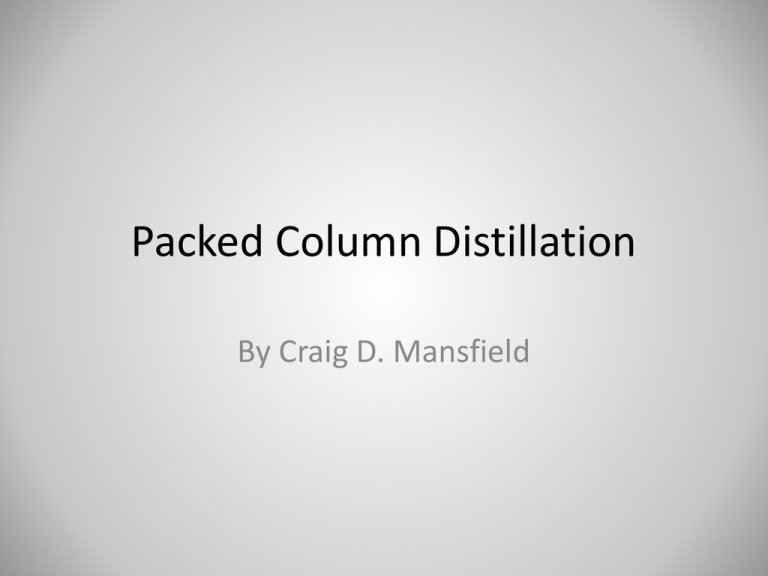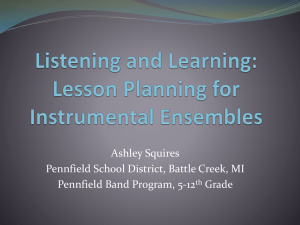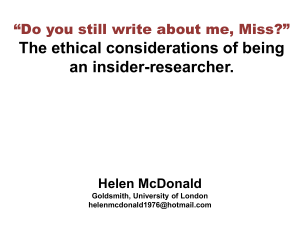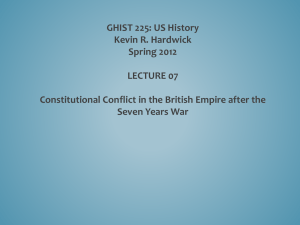Packed Column Distillation
advertisement

Packed Column Distillation By Craig D. Mansfield Some Background on Packed Column Distillation • Commonly uses – High value products – Heat sensitive products – Usually run in small/medium batches • Used since ~1907 – Patent for Raschig rings by Dr. Raschig in 1907 Comparison to Tray Columns Packed Advantages • Lower • • • • • • ∆𝑃 𝑧 Smaller column diameter Cheaper corrosive seps Less foaming Low liquid holdup Efficient batch operation Greater thermal control Tray Advantages • Can handle solids • High liquid rates • Large column diameter • Allows complex ops • Easier alt. feed locations • Better performance predictions • Higher residence time • Weigh less • Better wetting Research Problem Statement • Design/build a new packed distillation column for the UOL • Separate isopropanol and water • Operate in batch or continuous mode Basic Design Algorithm Used • Mixture properties • Flooding point data • Size/capacity of reboiler heat exchanger – Determine power source • Determine mass transfer performance • Size/capacity of reflux heat exchanger • Size/capacity of components and throughput – Volume of tanks/reboiler Mixture Properties • Used UniSim Design software – Viscosity, thermal cond., surface tension • Thermo models – gen. NRTL w/ PR • Diffusivity models – Wilke and Chang (diluted in water) – Sitaraman et al. (diluted in isopropanol) – Leffler and Cullinan (liquid mixture) – Gilliland (vapor mixture) T-X Diagram C3H7OH-H2O System T-X Diagram P = 1 atm 100 98 T_Bubble, T_Dew (degrees C) 96 94 92 90 T_Bubble 88 T_Dew 86 84 82 80 0 0.1 0.2 0.3 0.4 0.5 0.6 x_C3H7OH, y_C3H7OH 0.7 0.8 0.9 1 X-Y Diagram C3H7OH-H2O System X-Y Diagram P = 1 atm 1 0.9 0.8 y_C3H7OH 0.7 0.6 0.5 y 0.4 x 0.3 0.2 0.1 0 0 0.1 0.2 0.3 0.4 0.5 x_C3H7OH 0.6 0.7 0.8 0.9 1 Viscosity vs X C3H7OH-H2O System Liquid Viscosity vs X Diagram P = 1 atm 0.5 Liquid Viscosity x10^3 (Pa*s) 0.45 0.4 Liq. Viscosity 0.35 0.3 0.25 0 0.1 0.2 0.3 0.4 0.5 x_C3H7OH 0.6 0.7 0.8 0.9 1 Flooding Point • Column filled w/ liquid holdup from high vapor flow • Common flooding models – Sherwood et al. – GPDC • Used Sherwood et al. as model for design • Determined flooding vapor/liquid flow rates Power Source • Required power is 6.34 KW • Choices are electric or steam • Electric power (via resistance) requires a min. 52.8 amps of current • Steam is already available and efficient • Steam was chosen as the main power source Size of Reboiler Heat Exchanger • Used a vapor rate below flood point to find min. power requirement • Modeled reboiler w/ nucleate pool boiling • Correlations used: – Modified Thöme and Shakir model – Mostinski model • Calculated the area (“size”) required Mass Transfer Correlations • Onda et al. – Effective specific area – Interfacial Mass Transfer Coefficients Determination of Mass Transfer Performance (Transfer Units) • Used packed column design integral(s): 𝑥2 𝑧= 𝑥1 𝑦2 𝑧= 𝑦1 𝐻𝑂𝐿 𝐿 𝑧 = ′ ≈ 𝐾𝑥 𝑎 𝑁𝑂𝐿 𝐿 1 − 𝑥 ∗𝑀 𝑑𝑥 = 𝐻𝑂𝐿 𝑁𝑂𝐿 ′ ∗ 𝐾𝑥 𝑎 1 − 𝑥 𝑥 − 𝑥 𝑉 1 − 𝑦 ∗𝑀 𝑑𝑥 = 𝐻𝑂𝐺 𝑁𝑂𝐺 ′ ∗ 𝐾𝑦 𝑎 1 − 𝑦 𝑦 − 𝑦 𝑥2 𝑎𝑛𝑑 𝑁𝑂𝐿 = 𝑥1 1 − 𝑥 ∗𝑀 𝑧 𝑑𝑥 ≈ ∗ 1−𝑥 𝑥 −𝑥 𝐻𝑂𝐿 𝑧𝑡 vs 𝑥𝐵 C3H7OH-H2O System Column Height vs x_B Diagram P = 1 atm, x_D = 0.6 1.6 1.4 1.2 Z_t (m) 1 0.8 Series1 0.6 0.4 0.2 -0.1 0 6E-16 0.1 0.2 0.3 x_B 0.4 0.5 0.6 Size of Reflux Heat Exchanger • Sized to match or exceed max reboiler power – At flood – At highest transfer capacity • Model used: Nusselt horizontal pipe theory • Size was the transfer area required (again) The Nominal Model Column/Operation Specs • ID = 3 in. • 𝑧=2m • 𝑅𝐷 = 1 • 𝑄𝑅𝐵 = 6.34 KW • 𝑧𝑡 = 0.577 m • 𝐻𝑂𝐺 = 0.154 m • 𝑁𝑂𝐺 = 3.42 • HETP = 0.21 m Reboiler/Condenser Specs • • • • • • • 𝑈𝐴𝑅𝐵 = 94.96 W/K 𝑈𝐴𝐶 = 3.18 W/K Tube NPS = 0.5 in. 𝐿𝑅𝐵 = 0.320 m 𝐿𝐶 = 0.355 m 𝐴𝑅𝐵 = 0.01598 m2 𝐴𝐶 = 0.0177 m2 The Nominal Model Compositions • 𝑥𝐵 = 0.1 • 𝑥𝐷 = 0.6 • 𝑥𝐹 = 0.2 Average Efficiencies • 𝜖𝑎 = 0.80, z = 0.577 m • 𝜖𝑎 = 0.23, z = 2 m Flow Rates • B = 0.28 mol/s = 6.59 USGPH • F = 0.34 mol/s = 10.42 USGPH • D = 0.069 mol/s = 3.878 USGPH • L = 0.069 mol/s = 3.878 USGPH Core System Diagram Acknowledgements • • • • Dr. Lewis E. Johns Dr. Ranga Narayanan Dr. Spyros Svoronos The University of Florida References [1] E. Sada and T. Morisue, "Isothermal Vapor-Liquid Equilibrium Data of Isopropanol-Water System," Journal of Chemical Engineering of Japan, vol. 8, no. 3, pp. 191-195, 1975. [2] NFPA, NFPA 70: National Electrical Code, 11th ed., Delmar Cengage Learning, 2008. [3] D. W. Green and R. H. Perry, Eds., Perry's Chemical Engineers' Handbook, 8th ed., McGraw-Hill, 2008. [4] T. Ohta, "Representation of excess enthalpies by the PRSV equation of state with the modified Huron-Vidal first order and Wong-Sandler mixing rules," Fluid Phase Equilibria, vol. 129, pp. 89-103, 1997. [5] D. S. H. Wong, H. Orbey and S. I. Sandler, "Equation of State Mixing Rule for Nonideal Mixtures Using Available Activity Coefficient Model Parameters and That Allows Extrapolation over Large Ranges of Temperature and Pressure," Ind. Eng. Chem. Res., vol. 31, pp. 2033-2039, 1992. [6] J. Escandell, E. Neau and C. Nicolas, "A new formulation of the predictive NRTL-PR model in therms of kij mixing rules. Extension of the group contributions for the modeling of hydrocarbons in the presence of associating compounds," Fluid Phase Equilibria, vol. 301, pp. 80-97, 2011. [7] V. P. Carey, Liquid-Vapor Phase-Change Phenomena, 2nd ed., New York, NY: Taylor & Francis Group, LLC, 2008. [8] P. Ghosh and T. Taraphdar, "Prediction of vapor-liquid equilibria of binary systems using PRSV equation of state and Wong-Sandler mixing rules," Chemical Engineering Journal, vol. 70, pp. 15-24, 1998. [9] R. Stryjek and J. H. Vera, "PRSV2: A Cubic Equation of State for Accurate Vapor-Liquid Equilibria Calculations," The Canadian Journal of Chemical Engineering, vol. 64, no. October, pp. 820-826, 1986. [10] D.-Y. Peng and D. B. Robinson, "A New Two-Constant Equation of State," Ind. Eng. Chem., Fundam., vol. 15, no. 1, pp. 59-64, 1970. [11] H. Renon and J. M. Prausnitz, "Estimation of Parameters for the NRTL Equation for Excess Gibbs Energies of Strongly Nonideal Liquid Mixtures," I&EC Process Design and Developement, vol. 8, no. 3, pp. 413-419, 1969. [12] P. Rasmussen and A. Fredenslund, "UNIFAC Parameter Table for Prediction of Liquid-Liquid Equilibria," Ind. Eng. Chem. Process Des. Dev., vol. 20, pp. 331-339, 1981. [13] D. I. Shishin, A. L. Voskov and I. A. Uspenskaya, "Phase Equilibria in Water-Propanol(-1, -2) Systems," Russian Journal of Physical Chemistry A, vol. 84, no. 10, pp. 1667-1675, 2010. [14] M. Solorzano-Zavala, F. Barragan-Aroche and E. R. Bazua, "Comparative study of mixing rules for cubic equations of state in the prediction of multicomponent vapor-liquid equilibria," Fluid Phase Equilibria, vol. 122, pp. 99-116, 1996. [15] H. Orbey and S. I. Sandler, "A comparison of various cubic equation of state mixing rules for the simultaneous description of excess enthalpies and vapor-liquid equilibria," Fluid Phase Equilibria, vol. 121, pp. 67-83, 1996. [16] Honeywell, UniSim Design, R380 ed., Honeywell. [17] R. Bellman, Perturbation Techniques in Mathematics, Engineering and Physics, Mineola, NY: Dover Publications, Inc., 2003. [18] R. Bellman, Stability Theory of Differential Equations, Dover Publications, Inc., 2008. [19] A. L. Hines and R. N. Maddox, Mass Transfer: Fundamentals and Applications, Upper Saddle River, NJ: Prentice-Hall PTR, 1985. [20] S. Piché, F. Larachi and B. P. A. Grandjean, "Flooding Capacity in Packed Towers: Database, Correlations, and Analysis," Ind. Eng. Chem. Res., vol. 40, pp. 476-487, 2001. [21] R. Reed, Neural Smithing: Supervised Learning in Feedforward Artificial Neural Networks, The MIT Press, 1999. [22] S. Piché, F. Larachi and B. P. A. Grandjean, "Loading Capacity in Packed Towers - Database, Correlations and Analysis," Chem. Eng. Technol., vol. 24, no. 4, pp. 373-380, 2001. [23] H. Z. Kister, Distillation Design, McGraw-Hill, Inc., 1992. [24] A. Fazel, S. Ali, J. Ali Akbar, M. Ali Akbar and S. Ali Akbar, "Experimental investigation in pool boiling heat transfer of pure/binary mixtures and heat transfer correlations," IJCCE, vol. 27, no. 3, pp. 135-150, 2008. [25] S. G. Kandlikar, "Boiling Heat Transfer with Binary Mixtures: Part I - A Theoretical Model for Pool Boiling," Transactions of the ASME, vol. 120, pp. 380-387, 1998. [26] S. Kakac and H. Liu, Heat Exchangers: Selection, Rating, and Thermal Design, 2nd ed., CRC Press LLC, 2002. [27] K. Onda, H. Takeuchi and Y. Okumoto, "Mass Transfer Coefficients Between Gas and Liquid Phases in Packed Columns," Journal of Chemical Engineering of Japan, vol. 1, no. 1, pp. 56-62, 1968. [28] S. Piché, B. P. A. Grandjean and F. Larachi, "Reconciliation Procedure for Gas-Liquid Interfacial Area and MassTransfer Coefficient in Randomly Packed Towers," Ind. Eng. Chem. Res., vol. 41, pp. 4911-4920, 2002. [29] G. Q. Wang, X. G. Yuan and K. T. Yu, "Review of Mass-Transfer Correlations for Packed Columns," Ind. Eng. Chem. Res., vol. 44, pp. 8715-8729, 2005. [30] J. W. Buddenberg and C. R. Wilke, "Calculation of Gas Mixture Viscosities," Ind. Eng. Chem., vol. 41, no. 7, pp. 1345-1347, 1948. [31] W. Cao, K. Knudsen, A. Fredenslund and P. Rasmussen, "Simultaneous Correlation of Viscosity and VaporLiquid Equilibrium Data," Ind. Eng. Chem. Res., vol. 32, pp. 2077-2087, 1993. [32] F. M. Khoury, Predicting the Performance of Multistage Separation Processes, 2nd ed., CRC Press LLC, 2000. [33] F. Larachi, S. Levesque and B. P. A. Grandjean, "Seamless Mass Transfer Correlations for Packed Beds Bridging Random and Structured Packings," Ind. Eng. Chem. Res., vol. 47, pp. 3274-3284, 2008. [34] D. R. Lide and W. M. Haynes, Eds., CRC Handbook of Chemistry and Physics, 90th ed., Boca Raton, FL: CRC Press, 2009. [35] G. V. Rao and A. R. Balakrishnan, "Nucleate Pool Boiling Heat Transfer of Multicomponent Mixtures," Trans IChemE, Part A, Chemical Engineering Research and Design, vol. 82, no. A1, pp. 43-52, 2004. [36] V. G. Rifert, "Vapor COndensation Inside Horizontal Pipes," Inzhenerno-Fizicheskii Zhurnal, vol. 44, no. 6, pp. 1017-1029, 1983. [37] K. C. Pratt and W. A. Wakeham, "The Mutual Diffusion Coefficient for Binary Mixtures of Water and the Isomers of Propanol," Proceedings of the Royal Society of London. Series A, Mathematical and Physical Sciences, vol. 342, no. 1630, pp. 401-419, 1975. [38] R. Billet and M. Schultes, "Prediction of Mass Transfer Columns with Dumped and Arranged Packings: Updated Summary of the Calculation Method of Billet and Schultes," Trans IChemE, vol. 77, no. Part A, pp. 498-504, 1999. [39] R. Stryjek and J. H. Vera, "PRSV: An Improved Peng-Robinson Equation of State for Pure Compounds and Mixtures," The Canadian Jouranl of CHemical Engineering, vol. 64, no. April, pp. 323-333, 1986. [40] R. Stryjek and J. H. Vera, "PRSV - An Improved Peng-Robinson Equation of State with New Mixing Rules for Strongly Nonideal Mixtures," The Canadian Journal of Chemical Engineering, vol. 64, no. April, pp. 334-340, 1986. [41] Y. Demirel and H. O. Paksoy, "Calculations of thermodynamic derivative properties from the NRTL and UNIQUAC models," Thermochemica Acta, vol. 303, pp. 129-136, 1997. [42] T.-H. Chung, M. Ajlan, L. L. Lee and K. E. Starling, "Generalized Multiparameter Correlation for Nonpolar and Polar Fluid Transport Properties," Ind. Chem. Eng. Res., vol. 27, pp. 671-679, 1988. Questions?









